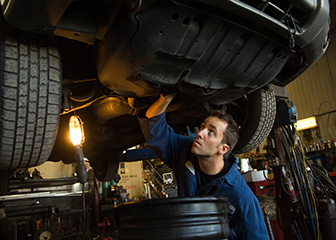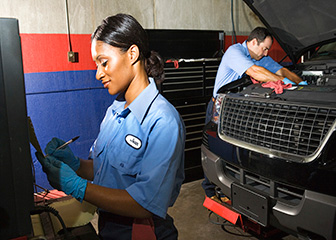How to Become an Automotive Service Technician or Mechanic About this section

Auto mechanics use specialized tools and equipment to make repairs.
Because automotive technology is becoming increasingly sophisticated, some employers prefer service technicians who have completed a formal training program in a postsecondary institution. Industry certification is usually required once the person is employed.
Education
High school courses in automotive repair, electronics, computers, mathematics, and English provide a good background for prospective service technicians. However, high school graduates often need further training to become fully qualified.
Completing a vocational or other postsecondary training program in automotive service technology is considered the best preparation for entry-level positions. Programs usually last 6 months to a year and provide intensive career preparation through classroom instruction and hands-on practice. Short-term certificate programs in a particular skill are also available.
Some service technicians get a 2-year associate’s degree. Courses usually include basic mathematics, computers, electronics, and automotive repair. Some programs have recently added classes in customer service, English, and other necessary skills.
Various automobile manufacturers and dealers sponsor 2-year associate’s degree programs. Students in these programs typically spend alternating periods attending classes full time and working full time in service shops under the guidance of an experienced technician.
Training
Most service technicians must complete on-the-job training, often as part of a formal education program.
Depending on a new service technician’s educational background, it typically takes 2 to 5 years of experience to become a fully qualified service technician. It then takes an additional 1 to 2 years of experience for service technicians to become familiar with all types of repairs.
New workers generally start as trainee technicians, technicians’ helpers, or lubrication workers and gradually acquire and practice their skills by working with experienced mechanics and technicians.
Licenses
The U.S. Environmental Protection Agency (EPA) requires all technicians who buy or work with refrigerants to be licensed in proper refrigerant handling. Formal test preparation is not required, but many trade schools, unions, and employer associations offer training programs designed for the EPA exam.
Certification
Certification from the National Institute for Automotive Service Excellence is the standard credential for service technicians. Certification demonstrates competence and usually brings higher pay. Many employers require their service technicians to become certified.
Certification is available in eight different areas, including: automatic transmission/transaxle, brakes, electrical/electronic systems, engine performance, engine repair, heating and air conditioning, manual drive train and axles, and suspension and steering.
For each area, technicians must have at least 2 years of experience (or relevant schooling and 1 year of experience) and pass an exam. To become a Master Automobile Technician, technicians must pass all 8 exams.
Important Qualities
Customer-service skills. Service technicians must discuss automotive problems—along with options to fix them—with their customers. Because self-employed workers depend on repeat clients for business, they must be courteous, good listeners, and ready to answer customers’ questions.
Detail oriented. Mechanical and electronic malfunctions are often due to misalignments or other easy-to-miss reasons. Service mechanics must, therefore, account for such details when inspecting or repairing engines and components.
Dexterity. Many tasks that service technicians do, such as disassembling engine parts, connecting or attaching components, and using handtools, require a steady hand and good hand–eye coordination.
Mechanical skills. Service technicians must be familiar with engine components and systems and know how they interact with each other. They must often take apart major parts for repairs and be able to put them back together properly.
Technical skills. Service technicians use sophisticated diagnostic equipment on engines, systems, and components. They must be familiar with electronic control systems and the appropriate tools needed to fix and maintain them.
Troubleshooting skills. Service technicians must be able to identify and fix problems in increasingly complicated mechanical and electronic systems.








